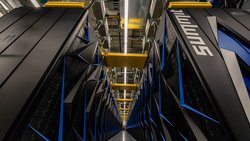
Sept. 19, 2018
By: Michael Feldman
A finalist for 2018 Gordon Bell Prize is for a science application that uses the mixed-precision capabilities of the GPU-powered Summit supercomputer to achieve 2.36 exops of performance.
 The annual Gordon Bell Prize is devised to recognize outstanding achievements in high performance computing, with a focus on science and engineering codes.
The annual Gordon Bell Prize is devised to recognize outstanding achievements in high performance computing, with a focus on science and engineering codes.
In this case, the application in question is based on a comparative genomics code, known as Combinatorial Metrics (CoMet), developed by a research team at Oak Ridge National Lab. CoMet is able to analyze genetic variations across a population to reveal genes that contribute to complex traits and conditions, such as susceptibility to cardiovascular disease, prostate cancer, Alzheimer’s disease and opioid addiction. This is the same application that previously achieved 1.88 exaops, when it was announced in conjunction with Summit’s launch in November.
The IBM-built Summit is the current champ on the TOP500 list, delivering a Linpack mark of 122.3 petaflops out of a theoretical performance of 187.7 petaflops, based on 64-bit floating point (FP64) arithmetic. However, due to the Tensor Cores in the system’s 27 thousand-plus NVIDIA V100 GPUs, the machine also provides more than three exaops of mixed-precision (FP16/FP32) peak performance.
CoMet was modified to take advantage of the Tensor Cores, which NVIDIA specifically designed to accelerate deep learning applications based on neural networks. In this case though, the ORNL team exploited the reduced-precision math to perform comparative genomics.
The work was originally reported in June and published in the May 2018 issue of Frontiers in Energy Research. According to computational scientist Wayne Joubert, CoMet’s lead developer, by using the V100 Tensor Cores and Summit’s much larger size, the team was able to run the application 25 times faster than it ran on Titan, ORNL’s previous top supercomputer.
“Although Tensor Cores weren’t designed with genomics data analysis in mind, as scientists we wondered if we could adapt our application to take advantage of the high performance offered by this NVIDIA feature,” said Joubert back in June. “In this case, we found a way to recast our problem to fit the hardware without losing accuracy and the results are pretty exciting. In one hour on Summit, we can solve a problem that would take 30 years on a desktop computer.”
It's noteworthy that five of the six Gordon Bell finalists are teams that used Summit, or its smaller sibling Sierra, at Lawrence Livermore, to run their applications. In addition to CoMet, these include codes in materials identification, earthquake modeling, subatomic physics, and weather prediction. The latter used deep learning techniques to identify extreme weather patterns from climate simulations, achieving 1.13 exaops.
The Gordon Bell Prize winner will be announced in November at SC18 in Dallas, Texas.
